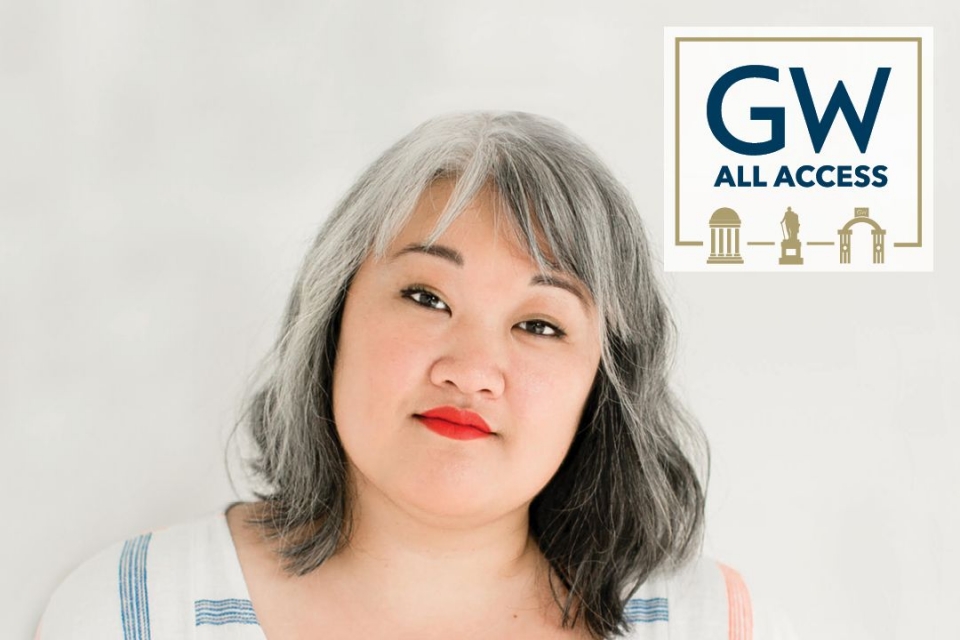Originally published on GW Today, August 10, 2020
by Ruth Steinhardt
As an art student, Michele Carlson had access to expensive materials, institutional space and all the hefty trappings of traditional printmaking. But after she graduated, she found herself suddenly cut off from all those resources and had to figure out how to put her skills to use in a much more improvisational, low-budget environment.
“Printmaking really defines itself by its relationship to equipment,” said Ms. Carlson, an artist, writer, critic and an associate professor of printmaking at the George Washington University Corcoran School of the Arts & Design. “So most academy-trained printmakers, especially if they’ve been working in fancy studios, graduate and go ‘How do I even make art anymore?’ After I graduated, I spent years figuring out how to just be a printmaker at my kitchen table, when I didn’t have any money and didn’t have any access.”
And she did: printing with wax paper stencils taped to the back of a screen, using inks she could wash out in a bathroom sink. That’s part of the reason Ms. Carlson views the upcoming semester of virtual learning less as an obstacle than as an opportunity for her students to engage with the craft like working artists—to become “kitchen table” printmakers, like generations of DIY activists and artists before them.
“Everything is going to be hand-printed, because it has to be,” Ms. Carlson said. “We’ll be tapping into those scrappy, DIY, anti-establishment aspects of printmaking—which is really how printmaking exists in the world, more than it does in these more traditional methods of teaching.”
Printmaking in the academic tradition “is very tied to European traditions of technique,” Ms. Carlson said. “It really relies on presses and on old heavy limestones that are carved from a quarry that doesn’t exist anymore and on chemicals and techniques that are reliant on very extensive fancy studios.”
But in the fall, Ms. Carlson’s students in Introduction to Printmaking and Printmaking Materials and Techniques will draw from non-Western canon printing traditions. They’ll use materials like the humble wooden spoon, which for centuries has been used in Japanese and other woodblock and relief printing traditions.
“This is an opportunity to kind of decolonize the syllabus and unmoor the entire tradition of printmaking from, essentially, the press, which is kind of radical in some ways,” Ms. Carlson said.
She and the Corcoran’s technical team also are rethinking the materials their students will work with. Access is a major question. Traditional printing doesn’t just use massive presses that weigh enough to require a reinforced floor. It can also require expensive, occasionally toxic inks and solvents that aren’t safe for most home users.
“We can’t ask students to buy a lot of solvents and oil-based inks and build a ventilation system in their living room,” Ms. Carlson said.
Ms. Carlson said that reevaluation will inform how she teaches after the COVID-19 pandemic ends, including using more eco-friendly materials and water-based inks.“You get into these grooves where you’re teaching things the same way with the same materials because that’s the stuff you’ve always used, and now you really have to investigate that and think about it—which is actually really nice,” she said. “There might be ways to take what we’re learning from this crisis scenario and make our studios more green in the future.”
Ms. Carlson said the location of the Corcoran’s Flagg Building, right across from the White House, should make students and instructors hyperaware of the tradition and necessity of art as a tool of social progress—even when they’re not physically in that space. Democratizing printmaking, which has been an essential medium for movement builders through history, is one way for students to demonstrate the power of their voices.
In one class project, students will work together in small groups to pick a social issue or concern that is personal to them and think about how to amplify and inform the public around that topic. Then they’ll use the printmaking methods they’ve learned to create and distribute an image that does that work.
The exercise, called “Calling Card,” is one of several ways Ms. Carlson hopes to create a sense of community among students who are physically separated. Another is to have “studio time” in which the class is working synchronously, with their cameras on, but not necessarily interacting or receiving formal instruction. Another might be a “print exchange,” in which students create and mail physical prints to each other.
“Coming together is a really important artistic and social tool,” especially for artists with marginalized identities, Ms. Carlson said. Examining oppressive systems has always been part of her practice, she said, and turning a critical eye on the European printmaking tradition in her classes this fall will tie into that too. While printing has been used to strengthen civil rights movements and amplify marginalized voices, it’s also been used to disseminate oppressive propaganda and to intimidate and silence those same voices.
“The nature of my practice and research is to reveal systemic injustices and blind spots, and often my work is working with communities who are the ones being redacted and are the ones being erased. How do we amplify all those voices? I think maybe the only way we can do that is to acknowledge where those active erasures are happening in the things we love,” she said.
“We love art, we love printmaking, but it also operates within the same systems that we’re marching on the street about. Art likes to pretend it’s separate from the world. But it’s not.”


